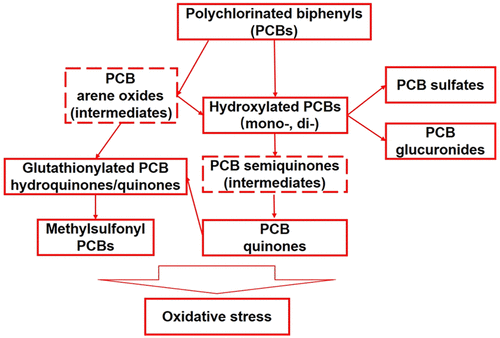当前位置:
X-MOL 学术
›
Chem. Res. Toxicol.
›
论文详情
Our official English website, www.x-mol.net, welcomes your feedback! (Note: you will need to create a separate account there.)
A Critical Review of Polychlorinated Biphenyls Metabolism, Metabolites, and Their Correlation with Oxidative Stress.
Chemical Research in Toxicology ( IF 4.1 ) Pub Date : 2020-07-17 , DOI: 10.1021/acs.chemrestox.0c00078 Jing Liu 1, 2 , Ya Tan 2 , Erqun Song 2 , Yang Song 2
Chemical Research in Toxicology ( IF 4.1 ) Pub Date : 2020-07-17 , DOI: 10.1021/acs.chemrestox.0c00078 Jing Liu 1, 2 , Ya Tan 2 , Erqun Song 2 , Yang Song 2
Affiliation

|
Polychlorinated biphenyls (PCBs) are notorious persistent organic pollutants that were banned in the last century. However, PCBs still remain ubiquitous in the ecosystem due to their persistence and bioaccumulative potency against environmental and biological degradation. Albeit there is no longer the permission of commercial production of PCBs, they were continuously released into global biota via illegal disposal of e-waste or as byproducts of industrial supplies. The role of oxidative stress is often implicated in PCBs’ toxicology. PCBs, especially coplanar ones, have a high affinity toward aryl hydrocarbon receptors and inducing CYP1A1, which is considered as a source of oxidative stress. Although commercial PCBs and coplanar individual PCBs, for example, PCB 77 and 126, induced oxidative stresses have been extensively investigated, PCB metabolite-induced oxidative stress has received less attention. PCBs can undergo phase I metabolism which metabolizes the parent PCBs into hydroquinone/semiquinone/quinone metabolites as a futile redox cycle, producing downstream reactive oxygen species (ROS) as byproducts. PCBs can also undergo phase II metabolism yielding methylsulfonyl metabolites that deplete glutathione and such. PCB metabolites induce oxidative stress generally via direct production of ROS or indirect scavenge antioxidant and inhibit antioxidant enzymes, disturbing cellular redox balance. This review aims to provide a critical summary of PCBs metabolism, PCBs parents, and daughter metabolite-induced oxidative stress. We especially focus on the connection between parent PCBs and downstream metabolites, to encourage research associated with PCB metabolite-induced oxidative stress.
中文翻译:

多氯联苯代谢、代谢物及其与氧化应激相关性的批判性审查。
多氯联苯(PCBs)是臭名昭著的持久性有机污染物,在上个世纪被禁止使用。然而,由于多氯联苯的持久性和对环境和生物降解的生物累积效力,它仍然在生态系统中无处不在。尽管不再获得多氯联苯的商业生产许可,但它们通过非法处置电子废物或作为工业供应的副产品不断释放到全球生物群中。氧化应激的作用通常与 PCB 的毒理学有关。PCB,尤其是共面 PCB,对芳烃受体具有高亲和力并诱导 CYP1A1,后者被认为是氧化应激的来源。尽管商业 PCB 和共面的单个 PCB,例如 PCB 77 和 126,已经广泛研究了诱导氧化应激,PCB 代谢物引起的氧化应激较少受到关注。PCB 可以经历 I 阶段代谢,将母体 PCB 代谢为对苯二酚/半醌/醌代谢物,作为无效的氧化还原循环,产生下游活性氧 (ROS) 作为副产品。PCB 还可以进行 II 期代谢,产生消耗谷胱甘肽等的甲基磺酰基代谢物。PCB 代谢物通常通过直接产生 ROS 或间接清除抗氧化剂并抑制抗氧化酶来诱导氧化应激,从而扰乱细胞氧化还原平衡。本综述旨在对 PCBs 代谢、PCBs 父代和子代代谢物诱导的氧化应激进行重要总结。我们特别关注母体 PCB 与下游代谢物之间的联系,
更新日期:2020-08-17
中文翻译:

多氯联苯代谢、代谢物及其与氧化应激相关性的批判性审查。
多氯联苯(PCBs)是臭名昭著的持久性有机污染物,在上个世纪被禁止使用。然而,由于多氯联苯的持久性和对环境和生物降解的生物累积效力,它仍然在生态系统中无处不在。尽管不再获得多氯联苯的商业生产许可,但它们通过非法处置电子废物或作为工业供应的副产品不断释放到全球生物群中。氧化应激的作用通常与 PCB 的毒理学有关。PCB,尤其是共面 PCB,对芳烃受体具有高亲和力并诱导 CYP1A1,后者被认为是氧化应激的来源。尽管商业 PCB 和共面的单个 PCB,例如 PCB 77 和 126,已经广泛研究了诱导氧化应激,PCB 代谢物引起的氧化应激较少受到关注。PCB 可以经历 I 阶段代谢,将母体 PCB 代谢为对苯二酚/半醌/醌代谢物,作为无效的氧化还原循环,产生下游活性氧 (ROS) 作为副产品。PCB 还可以进行 II 期代谢,产生消耗谷胱甘肽等的甲基磺酰基代谢物。PCB 代谢物通常通过直接产生 ROS 或间接清除抗氧化剂并抑制抗氧化酶来诱导氧化应激,从而扰乱细胞氧化还原平衡。本综述旨在对 PCBs 代谢、PCBs 父代和子代代谢物诱导的氧化应激进行重要总结。我们特别关注母体 PCB 与下游代谢物之间的联系,



























 京公网安备 11010802027423号
京公网安备 11010802027423号